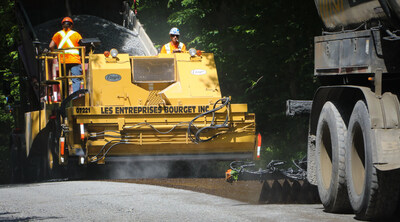JOLIETTE, QC, July 17,
2024 /CNW/ - Contrary to the municipal world,
which uses surface treatment as an effective technique that is less
costly than conventional asphalt, Entreprises Bourget, a major
player in road maintenance for over 60 years, describes the
position of the Ministère des Transports du Québec as erratic,
pointing to the recent report by the Vérificateur général du Québec
(VGQ), which notes that the deterioration of the road network's
pavements is increasing; MTMD's failure to assess the investments
needed to bring the asset maintenance deficit under
control.

This shortcoming is all the more problematic, in the company's
view, given the context of climate change, which is likely to
increase the scale of the investments required to control this
deficit, according to the same report. Given that 50% of
Quebec's road network is in poor
condition, surface treatment can be a pragmatic solution, as it
restores worn or uncoated pavements to a surface whose service life
can be extended by several years, while protecting the integrity of
the pavement itself.
"Since 80% of Quebec's road
network is made up of low-volume roads, surface treatment is the
ideal solution for uncoated pavements, and the optimum alternative
for extending the life of damaged pavements by at least 4 to 7
years, depending on the case," says company president
Luc Delangis. He pointed out that it
is generally more costly for the government to intervene in the
aftermath of a disaster than to invest in prevention, recalling the
facts reported by the VGQ, which states that every dollar invested
in adaptation avoids an average of between $13 and $15 in
direct damage to roads resulting from disasters, not counting the
indirect damage to the economy.
Among the collateral damage resulting from poor road conditions,
automobile maintenance costs for Quebec drivers are 2 times higher. A recent
study by the Canadian Automobile Association (CAA) puts these costs
at $258 per year, compared with
$126 for Canadian motorists.
The 50% of roads in poor condition is enough to justify a
drastic change of course to at least delay the growth of the asset
maintenance deficit (AMD), especially since the MTMD's Independent
Expert Panel considers that "a perfect storm seems to be brewing on
the horizon with regard to the state of the road network: the road
network's asset maintenance budgets were already chronically
insufficient to halt the growth of the AMD". Given the current
context, more than 20,000 km of the 32,000 km of roads under the
responsibility of the Ministry of Transport could benefit from this
type of intervention, regardless of the formula chosen. "At 60%
less costly than conventional asphalt, surface treatment would be
an inexpensive solution paid for to delay the deterioration of the
road network," continued Mr. Delangis, pointing out that
high-performance surface treatments are also available, consisting
of premium-quality aggregate and polymer emulsion designed to last
even longer under higher traffic loads.
There is therefore no justification for MTMD's incomprehensible
stubbornness in not using this technique which, in addition to its
obvious economic virtues, offers advantages in terms of reduced
energy consumption and greenhouse gas (GHG) emissions, since it is
cold mix, quick and easy to apply, and minimizes the impact on
traffic during the works.
For the company, there's still time for the Ministère des
Transports du Québec to react quickly, inviting it to emulate the
governments of Ontario,
New Brunswick and the New England
states, which have successfully invested tens of millions of
dollars in this type of surfacing year after year, saving five
times as much in the end, with a blitz of urgent work across
Quebec that would help extend the
life of our national roads.
SOURCE Les Entreprises Bourget Inc.